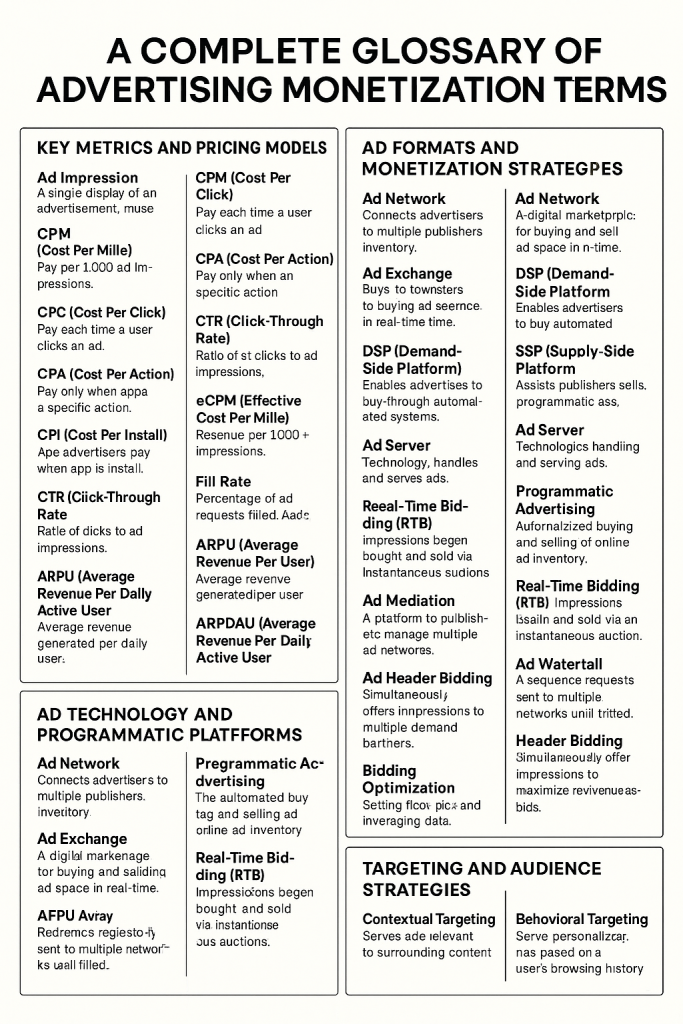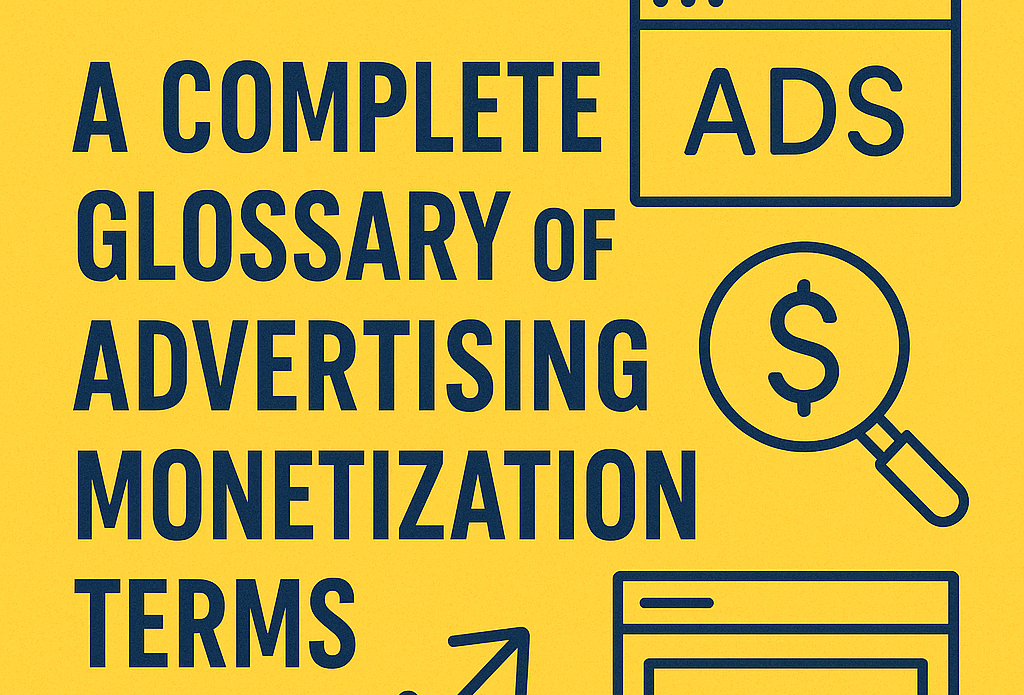A Complete Glossary of Advertising Monetization Terms
Whether you’re a publisher seeking to maximize revenue from your website or app, an advertiser looking to optimize campaign performance, or a business professional making strategic decisions about digital monetization, fluency in these concepts directly impacts your ability to succeed financially. These terms aren’t just technical jargon—they represent the metrics, strategies, and technologies that determine how much money you can earn from your digital properties, how effectively you can reach your target audience, and how well you can compete in an increasingly sophisticated marketplace.
Contents
Key Metrics and Pricing Models
Ad Impression:
A single display of an advertisement to a user, representing the fundamental unit of ad delivery measurement. Impressions count each time an ad is shown regardless of whether it’s viewed by the same user multiple times. This metric serves as the baseline for most advertising calculations and directly impacts revenue potential. Publishers track impressions to understand their inventory volume, while advertisers use impressions to gauge campaign reach. Higher impression counts can lead to increased revenue, though quality targeting and placement significantly affect monetization effectiveness across both desktop and mobile platforms.
CPM (Cost Per Mille):
A pricing model where advertisers pay publishers for every 1,000 ad impressions delivered. CPM represents the monetary value assigned to one thousand ad views, making it essential for publishers to compare earning potential across different inventory types and placements. A mobile banner with a $2 CPM generates $2 for every 1,000 views, while premium video content might command $10+ CPM. This model provides predictable revenue streams and is widely used across desktop display advertising, mobile apps, and video platforms, with rates varying significantly based on audience quality, geographic location, and content category.
CPC (Cost Per Click):
A performance-based pricing model where advertisers pay only when users actively click on their advertisements. Publishers earn revenue through user engagement rather than passive views, making ad placement and creative quality crucial for maximization. CPC campaigns focus on driving traffic and are common in search advertising, social media, and content marketing. The effective earnings per impression fluctuate based on click-through rates, meaning engaging ad placements can significantly outperform passive display positions. Mobile CPC rates often differ from desktop due to varying user behavior patterns and screen real estate limitations.
CPA (Cost Per Action):
An advanced pricing model where payment occurs only after users complete specific predetermined actions such as purchases, registrations, or app downloads. This model transfers performance risk to publishers, who must not only attract clicks but also drive conversions through their traffic quality. CPA arrangements are common in affiliate marketing, lead generation, and mobile app user acquisition campaigns. Publishers typically demand higher rates for CPA deals due to the additional risk and optimization requirements. Success depends heavily on audience alignment between the publisher’s users and the advertiser’s target demographic.
CPI (Cost Per Install):
A specialized subset of CPA focusing specifically on mobile app installations, where advertisers pay for each successful app download and installation generated through the publisher’s traffic. CPI is fundamental to mobile user acquisition strategies, particularly in gaming where developers promote new titles through existing game networks. Publishers running CPI campaigns through offerwalls or rewarded placements earn revenue tied directly to installation completion. Rates vary significantly based on app category, geographic targeting, and installation quality requirements, with some advertisers requiring additional engagement metrics beyond simple installation.
CTR (Click-Through Rate):
The percentage of ad impressions that result in user clicks, calculated as (clicks ÷ impressions) × 100%. CTR serves as a key performance indicator for ad engagement and creative effectiveness. While not directly a revenue metric, CTR significantly influences monetization by affecting both advertiser willingness to pay premium rates and platform algorithm preferences for ad placement. High-CTR ads often command better positioning and higher CPMs because they demonstrate value delivery to advertisers. Publishers optimize CTR through strategic placement, relevant targeting, and creative testing to maximize overall revenue performance.
eCPM (Effective Cost Per Mille):
A normalized revenue metric representing earnings per 1,000 impressions across all pricing models, calculated as (total revenue ÷ total impressions) × 1,000. eCPM enables publishers to compare monetization performance across different ad formats, networks, and campaigns on an equal basis. For example, a rewarded video generating $100 from 20,000 impressions has a $5 eCPM, directly comparable to banner performance. This metric is crucial for optimization decisions, helping publishers identify the most profitable inventory allocation and partnership strategies across both mobile and desktop platforms.
Fill Rate:
The percentage of ad requests successfully fulfilled with paying advertisements, calculated as (filled impressions ÷ total ad requests) × 100%. Fill rate directly impacts revenue potential since unfilled requests represent lost monetization opportunities. Low fill rates may indicate insufficient demand in specific geographic regions, technical integration issues, or overly restrictive targeting parameters. Publishers optimize fill rates through diversified demand partnerships, mediation platforms, and strategic floor pricing. Mobile apps particularly focus on fill rate optimization since user sessions generate multiple ad opportunities that must be maximized for sustainable revenue.
ARPU (Average Revenue Per User):
The average revenue generated per user over a specific time period, typically calculated monthly as total revenue divided by active user count. ARPU encompasses all monetization streams including advertising, in-app purchases, and subscriptions, providing a comprehensive view of user value. For advertising-focused analysis, publishers often calculate ad-specific ARPU to understand user monetization efficiency through advertising alone. This metric helps evaluate business model effectiveness and guides user acquisition spending by establishing lifetime value benchmarks.
ARPDAU (Average Revenue Per Daily Active User):
Daily revenue per active user, calculated as total daily revenue divided by unique daily active users. ARPDAU is particularly important for mobile apps and games where users engage daily and generate regular ad revenue through session-based monetization. This metric provides immediate feedback on monetization changes and seasonal patterns, enabling rapid optimization of ad frequency, placement, and format decisions. Higher ARPDAU indicates effective daily engagement monetization, crucial for sustainable free-to-play business models.
Ad Formats and Monetization Strategies
Banner Ads:
Traditional rectangular display advertisements positioned at page margins or screen edges, typically measuring 728×90 pixels on desktop or 320×50 pixels on mobile. Banners represent the foundational ad format for digital monetization, offering persistent visibility without interrupting user experience. While implementation is straightforward and user-friendly, banner ads generally yield lower CPMs compared to more immersive formats due to their small size and passive nature. Publishers use banners for consistent baseline revenue, often combining them with higher-impact formats for comprehensive monetization strategies across web and mobile platforms.
Interstitial Ads:
Full-screen advertisements that completely cover the host interface, strategically displayed during natural transition points such as app loading screens, level completions, or page navigations. These ads command higher CPMs due to their prominent visibility and user attention capture. However, their intrusive nature requires careful timing to avoid negative user experience impacts. Mobile games commonly use video interstitials between gameplay sessions, while websites may display them during content transitions. Success depends on balancing revenue potential with user satisfaction through strategic placement timing.
Rewarded Video Ads:
User-initiated advertisements offering in-app rewards in exchange for complete viewing, typically lasting 15-30 seconds. This opt-in format creates positive user experiences since viewers actively choose engagement for tangible benefits like virtual currency, extra lives, or premium content access. Rewarded videos generate strong monetization performance through high completion rates and premium CPMs, as advertisers value the engaged viewing experience. Mobile games extensively use this format as a core monetization pillar, integrating rewards seamlessly into gameplay progression and virtual economy systems.
Native Ads:
Advertisements designed to match the visual style, context, and functionality of surrounding content, creating less intrusive user experiences while maintaining clear sponsored content disclosure. Examples include promoted social media posts, recommended content widgets, and in-game branded elements that blend naturally with the environment. Native ads often achieve higher engagement rates due to their contextual relevance and non-disruptive presentation. Publishers across web and mobile platforms use native formats to monetize content feeds and user interfaces while preserving user experience quality.
Playable Ads:
Interactive advertisements allowing users to experience mini-versions of games or apps directly within the ad unit before installation prompts. This format primarily serves mobile game marketing, enabling potential users to trial gameplay mechanics and graphics quality before committing to downloads. Playable ads typically generate premium CPMs and higher conversion rates due to pre-qualified user interest and engagement. Publishers benefit from enhanced user experience as players often enjoy trying new games through ad interactions, creating positive monetization cycles.
Offerwall:
Monetization units presenting users with multiple reward-based advertising opportunities including app installations, video viewing, surveys, and service registrations. Offerwalls typically operate within mobile games as “Free Coins” or reward sections, allowing users to choose engagement levels and reward types. Revenue generation occurs through CPA and CPI models, with publishers earning bounties for completed actions. This format provides incremental monetization by tapping performance advertising budgets while giving users control over their advertising experience and reward earning.
In-Game Immersive Ads:
Advanced advertising integration blending promotional content directly into 3D game environments through billboards, branded items, virtual storefronts, or interactive portals. These ads maintain gameplay immersion by appearing as natural environmental elements rather than interrupting sessions with separate ad sequences. Examples include trackside sponsor banners in racing games or branded virtual spaces accessible through in-game portals. This emerging format represents the evolution toward seamless advertising integration that enhances rather than disrupts user experience.
Ad Technology and Programmatic Platforms
Ad Network:
Intermediary platforms aggregating publisher inventory and connecting it with advertiser demand through consolidated buying opportunities. Ad networks simplify advertising by providing single points of contact for reaching multiple websites or apps simultaneously, often segmenting inventory by audience demographics or content categories. Publishers integrate with networks to fill ad slots and generate revenue, while networks retain service fees from transactions. Traditional networks have evolved to compete with programmatic platforms by offering enhanced targeting and optimization capabilities.
Ad Exchange:
Digital marketplaces facilitating automated buying and selling of advertising inventory through real-time auction mechanisms. Exchanges operate more openly than traditional networks, connecting publishers (via SSPs) with advertisers (via DSPs) through instantaneous bidding processes. Pricing determination occurs through real-time auctions completing within milliseconds as users load content. Publishers access broader demand pools through exchange connectivity, potentially increasing fill rates and CPMs through competitive bidding dynamics across diverse buyer populations.
DSP (Demand-Side Platform):
Software platforms enabling advertisers to automate ad purchasing across multiple exchanges and networks through unified interfaces. DSPs allow buyers to set targeting parameters, budgets, and bidding strategies while algorithms execute real-time bidding decisions based on campaign objectives. Instead of manual negotiations with individual publishers, advertisers access millions of impressions across numerous properties simultaneously. DSPs bring competitive demand to publisher inventory through programmatic marketplace participation, driving auction competition and pricing optimization.
SSP (Supply-Side Platform):
Publisher-focused platforms managing and optimizing advertising inventory monetization across multiple demand sources through programmatic connections. SSPs serve as publisher counterparts to DSPs, connecting inventory to various exchanges, networks, and direct buyers simultaneously. Publishers can establish floor prices, block unwanted advertisers, and prioritize demand sources through SSP interfaces. These platforms conduct auctions and manage bid requests to maximize yield through competitive demand optimization and sophisticated pricing strategies.
Ad Server:
Technology platforms storing advertising creatives and managing their delivery to user devices at appropriate times based on targeting criteria and campaign parameters. Ad servers handle both publisher-side inventory management and advertiser-side creative housing and tracking. When users access content, ad servers determine which advertisements to display based on auction results, targeting rules, and campaign priorities. These systems ensure proper ad delivery while tracking performance metrics like impressions, clicks, and conversions for optimization and billing purposes.
Programmatic Advertising:
Automated advertising transaction systems using software platforms and algorithms to buy and sell inventory electronically, replacing manual negotiation processes. Programmatic encompasses real-time bidding, private marketplace deals, and programmatic guaranteed arrangements, with machine-based decision making occurring within milliseconds. This automation increases efficiency, targeting precision, and scale while reducing transaction costs. Publishers benefit from increased demand competition and optimized pricing, while advertisers gain enhanced targeting capabilities and inventory access.
Real-Time Bidding (RTB):
Auction mechanisms within programmatic advertising where individual impressions are sold through instantaneous competitive bidding as content loads. When users trigger ad opportunities, bid requests containing anonymous data and context are distributed to potential buyers who respond with competitive bids within approximately 100 milliseconds. Highest bids win and corresponding ads are served immediately. RTB creates open marketplace dynamics similar to stock exchanges, with pricing determined by live supply and demand interactions.
Ad Mediation:
Mobile-focused platforms enabling publishers to manage multiple ad networks and demand sources through unified systems rather than integrating numerous individual SDKs. Mediation platforms serve as intermediary layers managing ad requests across various networks through either sequential waterfall approaches or simultaneous in-app bidding processes. Publishers integrate single mediation SDKs while gaining access to multiple demand partners through centralized dashboards. This approach optimizes revenue through automated network selection and competitive yield optimization.
Ad Waterfall:
Traditional ad serving methodology where demand sources are contacted in predetermined priority order for each impression opportunity. Requests “waterfall” through network lists based on historical performance or strategic priorities, with higher-tier partners receiving first opportunities before requests pass to subsequent tiers. While simple to implement, waterfalls can be inefficient since lower-priority networks might bid higher for specific impressions than those receiving initial opportunities. This approach dominated mobile ad mediation before advanced bidding technologies emerged.
Header Bidding:
Advanced programmatic technique allowing publishers to simultaneously offer impressions to multiple demand sources before ad server calls, increasing competition and revenue potential. Header bidding bypasses traditional waterfall limitations by enabling concurrent bid collection from various exchanges and DSPs. When users access content, header scripts trigger simultaneous bid requests, with collected bids competing directly for serving opportunities. This approach typically increases publisher revenue through enhanced competition while reducing latency compared to sequential demand partner queries.
Bidding Optimization:
Strategies and technologies for maximizing programmatic advertising revenue through auction dynamic improvements and algorithmic pricing adjustments. Publishers optimize bidding through floor price management, demand source prioritization, and automated yield optimization tools analyzing performance data. These techniques balance revenue maximization with fill rate maintenance, using machine learning algorithms to adjust pricing strategies based on geographic, temporal, and audience factors for optimal monetization performance across various inventory types and demand sources.
Targeting and Audience Strategies
Contextual Targeting:
Advertisement delivery based on content context rather than user personal data, analyzing webpage or app content to match relevant promotional materials. Systems examine keywords, topics, and contextual signals to align advertisements with current user interests and content themes. For example, fitness articles might display sporting goods advertisements while cooking content shows kitchen appliance promotions. This approach ensures advertisement relevance while respecting user privacy, making it increasingly important as data privacy regulations expand globally.
Behavioral Targeting:
Advertisement selection based on user historical activity patterns including website visits, searches, purchases, and engagement behaviors. This approach creates detailed user profiles enabling precise interest-based targeting regardless of current content context. Advertisers segment audiences by demonstrated behaviors and preferences, delivering personalized messaging to users most likely to engage with specific products or services. While highly effective for conversion optimization, behavioral targeting faces increasing privacy scrutiny and regulation requiring careful implementation and user consent management.


